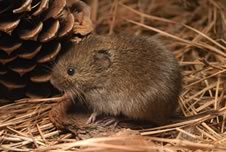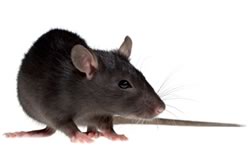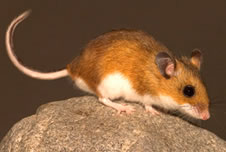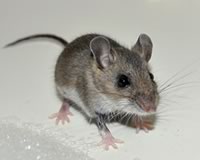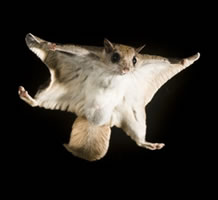
RODENT CONTROL
Rodents are mammals of the order Rodentia, which are characterized by a single pair of unremittingly growing incisors in each of the upper and lower jaws. About forty percent of all mammal species are rodents; they are found in vast numbers on all continents except Antarctica. They are the most diversified mammalian order and live in a variety of terrestrial habitats, including human-made environments. There are species that are arboreal, fossorial (burrowing), and semiaquatic. Well-known rodents include mice, rats, squirrels, prairie dogs, porcupines, beavers, guinea pigs, hamsters, and capybaras. Furthermore, they are vectors for diseases like Salmonella, Tapeworms, Hantavirus, and the Plague. If you suspect a mouse infestation contact a pest management professional.
Arkansas Rodents
House Mouse
Identification:
Color: Dusty gray with a cream belly
Shape: Round
Size: 2.5 to 3.75 inches long
Food: Mainly feed on plants, but are omnivorous
Habitat: Dependent on associations with humans, so typically found in and around homes
Region: Found throughout the world
Prevention:
- Seal holes and cracks around home that lead to interior. Pay attention to crawlspace vents, garage doors, and any place where pipes, wires, or other utilities enter home.
- Reduce clutter in and around home.
- Mice love to build nests in cardboard boxes,
- so use sealed plastic boxes and bins for storage.
- Check home regularly for droppings, nests, and damaged food containers
Deer Mice
Deer mice are nocturnal and prefer rural, outdoor areas. They are a common problem in farming areas, vacation homes, and outbuildings. They are excellent climbers. They are common carriers of the Hantavirus which is transmitted by the inhalation of dust particles contaminated by urine, feces, or saliva.
Identification:
Color: Brown with light feet and underbelly
Shape: Round
Size: 2.75 to 4 inches long
Food: Seeds, nuts, small fruits, berries, and insects
Habitat: Deer mice often nest in tree hollows, log piles, and beneath decks. During winter months, they seek shelter indoors preferring stuffed furniture, wall voids, and tight areas in basements or attics.
Region: Found throughout the U.S.
Other Features: Deer mice have multi-colored tails; usually half white and half brown.
Prevention:
- Seal holes and cracks around home that lead to interior. Pay attention to crawlspace vents, garage doors, and any place where pipes, wires, or other utilities enter home.
- Reduce clutter in and around home
- Mice love to build nests in cardboard boxes, so use sealed plastic boxes and bins for storage
- Check home regularly for droppings, nests, and damaged food containers
Norway Rats
Norway Rats are the most common of all rat species. They are commonly called the brown rat, common rat, street rat, or sewer rat. They can live virtually anywhere and often nest close to where humans dwell. They are nocturnal, forage, and often live in large social groups. They are adept at burrowing and will often gnaw through anything from plastic, to lead pipes to obtain food or water.
Identification:
Color: Brown or gray with scattered black hairs; gray or white underside
Shape: Long, heavy bodies, blunt muzzle, small ears and eyes
Size: 15 to 20 inches long
Food: Virtually anything, especially cereal, pasta, and corn
Habitat: They often nest in basements and in debris or undisturbed materials. They prefer damp environments, like sewage systems.
Region: Found throughout the U.S.
Prevention:
- Store food in tightly sealed containers
- Reduce clutterEliminate sources of moisture.
- Fill any holes or gaps with silicone caulk
Keep home, especially kitchens, swept and free of food particles. - If you suspect an infestation, contact a licensed professional for removal
.
Roof Rats
Identification:
Color: Brown with black intermixed; Gray, white or black underside
Shape: Long and thin with scaly tail; large ears and eyes
Size: 16″ total (6-8″ body plus 6-8″ tail) inches long
Habits: Roof rats are primarily nocturnal. They forage for food in groups of up to ten and tend to return to the same food source time after time. These rats follow the same pathway between their nest and food.
Habitat: Roof rats live in colonies and prefer to nest in the upper parts of buildings. They can also be found under, in and around structures.
Region: Coastal states and the southern third of the U.S
Other Features:
Roof rats are strongly arboreal (tree inhabitants) and travel along power lines to trees, oleanders, vines, and roofs.
They can climb up brick, concrete block and other rough surfaces.
They can jump 2 feet up and 4 feet horizontally (double the horizontal distance if they are jumping from a height).
Ground covers and compost bins also provide safe travel routes and nests
During twilight and nighttime hours, within a territory 200 to 300 feet from their daytime nesting locations.
They thrive in cool weather and are most active from November through May.
Nesting Requirements: Roof rats nest outside in trees, woodpiles and debris, and in dense vegetation. Inside, roof rats prefer to nest in the upper levels of a building in the attic and ceiling.
Prevention:
- Seal holes and cracks around home that lead to interior. Pay attention to crawlspace vents, garage doors,
- and any place where pipes, wires, or other utilities enter home.
- Trim foliage back at least 4 feet from the home
- Check attic for signs of droppings or trails in the insulation
- Check home regularly around the soffit and fascia area for holes
Voles Rats
Voles are often called field or meadow mice, although they are not actually mice. These burrowing rodents can cause massive amounts of damage to lawns, crops, and orchards. If you suspect an infestation, contact a pest management professional.
Identification:
Color: Variations of black, brown, and gray
Shape: Mouse-like, but rounder and stouter
Size: 4.5 to 5.5 inches long, including the tail
Food: Vegetation like grass, seeds, flowers, leaves, and roots
Habitat: Live in shallow burrows with nests made of vegetation.
Region: Found throughout the world.
Other Features: Leave runways through grass that lead to entrances to burrows. Entrances are round and are up to 2 inches in diameter.
Prevention:
- Regularly look for trails, burrows, and droppings that are evidence of vole infestation.
- Modify habitat around affected area by removing weeds, mulch, and other vegetation.
- Use exclusions with mesh and fencing.
- Girdle trees around trunks with mesh, metal, or plastics.
- If populations are small, trapping may be an option.
Chipmunks
Identification:
Color: Reddish-brown fur on its upper body and five dark brown stripes contrasting with light brown stripes along its back, ending in a dark tail.
Shape: Small Squirrel like
Size: It can reach about 12 in. in length including the tail.
Food: It prefers bulbs, seeds, fruits, nuts, green plants, mushrooms, insects, worms, and bird eggs.
Habitat: The eastern chipmunk lives in deciduous wooded areas and urban parks throughout the eastern United States and southern
Canada. It prefers locations with rocky areas, brush or log piles, and shrubs to provide cover.
Region: North America
Other Features: It can climb trees well but constructs underground nests with extensive tunnel systems, often with several entrances. To hide the construction of its burrow, the eastern chipmunk carries dirt to a different location in its cheek pouches. It also lines the burrow with leaves, rocks, sticks, and other material, making it even harder to see. It has several bird-like or chattering calls; one is a trill at the rate of 130 vibrations per minute and another is a lower-pitched, clicking sound.
Southern Flying Squirrels
Identification:
Color: Their fur is grey or brown on the upper part of their body. Their underneath parts are grey colored.
Shape: They have small and round shaped heads. Their eyes are round, big and black colored. They have tiny and pointed ears on two sides of their heads.
Size: They are about 7.75 inches to 10 inches long measuring from their heads to tails.
Food: Southern flying squirrels mainly diet on acorns, berries, seeds and nuts, eggs of birds, lichens, small dead animals and insects.
Habitat: These squirrels dwell in deciduous forests. They reside on high up the trees in abandoned nests of grey squirrels and woodpeckers’ holes.
Other Features:
Though their name suggest that they might fly, but in real they glide.
Despite having wings and gliding ability this species is a mammal.
These squirrels attain sexual maturity in just 1 year of age.
They are very friendly creatures.
Their existence is completely safe despite the environment being affected and wildlife affected in turn.
 Little Rock, AR 501-868-3837 | Russellville, AR 479-968-4777 | Hot Springs, AR 501-442-5653 | Fayetteville, AR 479-899-6874
Little Rock, AR 501-868-3837 | Russellville, AR 479-968-4777 | Hot Springs, AR 501-442-5653 | Fayetteville, AR 479-899-6874


